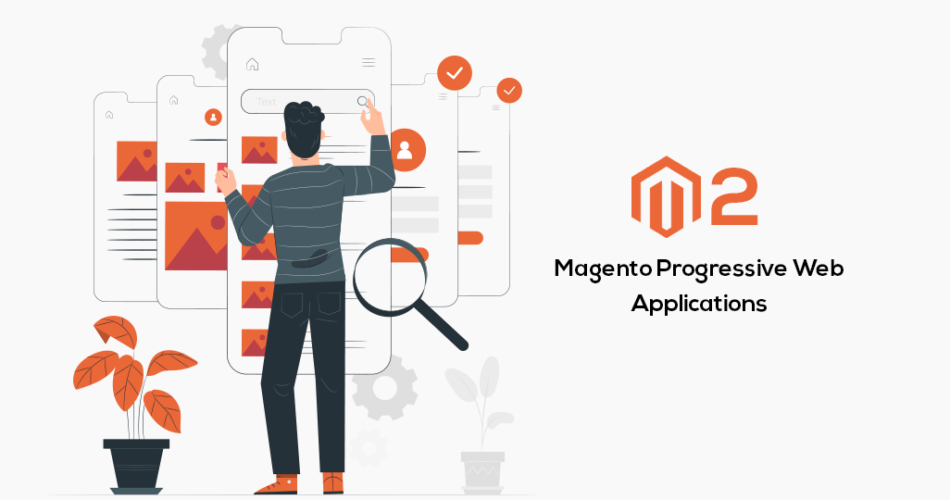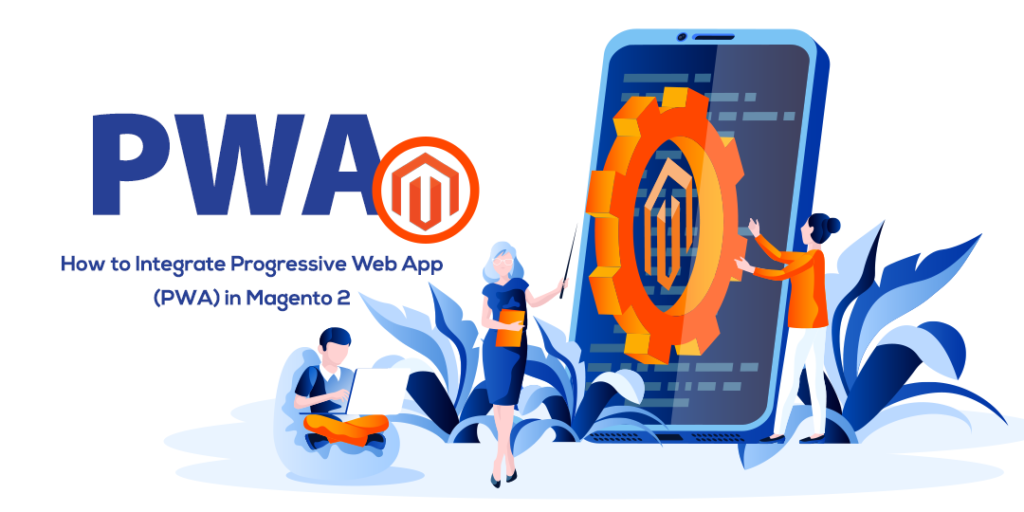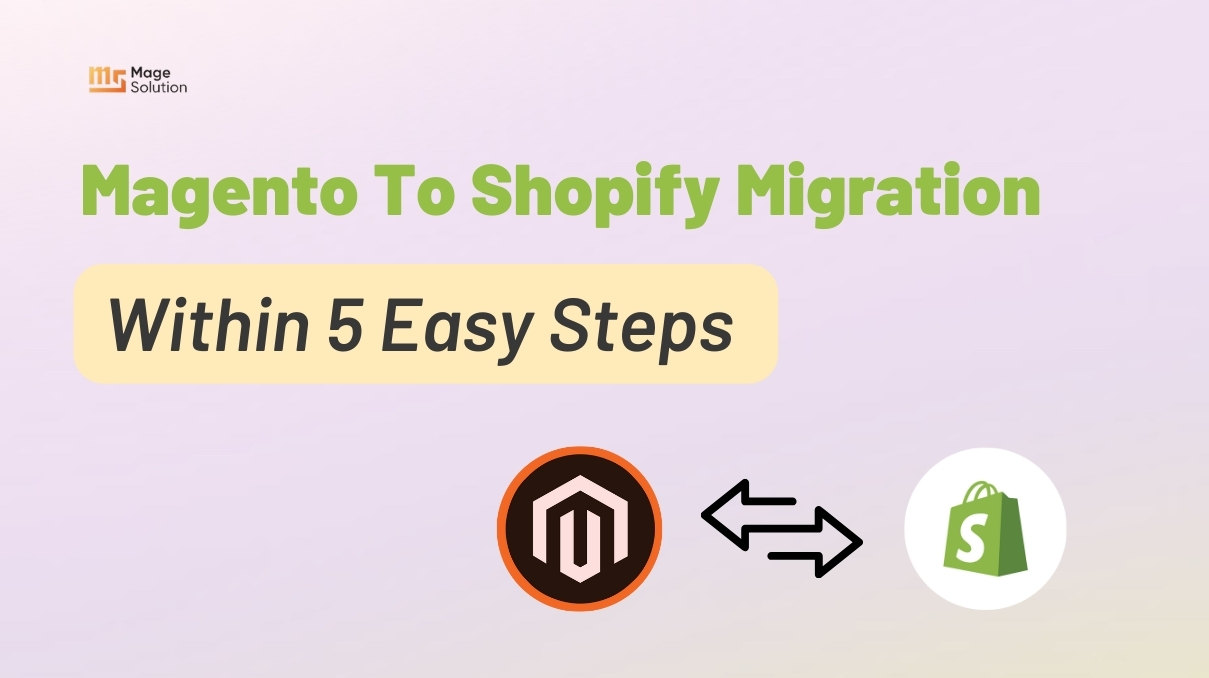Your cart is currently empty!
The comprehensive guide to build Magento 2 PWA
Magento is always a favorite platform for businesses to start their online store. However, because of the advantage of Magento, more and more companies jump into this market to extend their opportunity and customer experiences. Therefore, the online market becomes quite competitive. As a result, businesses always have to catch up with cutting-edge technology to compete with competitors. Progressive Web Apps or PWA is one of the modern technologies that lots of companies want to integrate this app for online stores. And Magento 2 PWA is a perfect choice. In this article, we will give you a detailed checklist to build Magento 2 PWA in the simplest way.
First of all, you need to know about Progressive Web App

So what exactly is a Progressive Web App?
A progressive web app looks and feels like a native app, but works directly in mobile browsers. There is no need to download anything from an App Store. Customers get an app-like experience instantly in their browsers instead.
Some outstanding features of the Progressive Web App
The capability of offline work: Service workers – the technology is responsible for that feature. Thus, it allows the app to store things offline and flexibly manage network requests to retrieve them. As a result, it leads to minimizing the amount of data we need to use to run the app.
Discoverability and easy installation: A PWA is a website with some extras that can be discovered through regular search engines like Google or Bing. Hence, users have no need to download anything from app stores. A PWA’s installation is really easy, it happens in the background during the first visit.
Usage of phone features: PWAs have a lot of possibilities to access device features on Android and a few less on iOS. The usage of cameras, GPS, or fingerprint scanners in an app-like way enriches the user’s experience.
Automatic updates: A PWA allows publishers to implement patches immediately. Moreover, it enables them to keep full control of the content. Customers always use the most current version of the application.
Safety: By using the HTTPS protocol, the data is safe because of encryption, and thus more difficult to intercept and change. Moreover, users perceive HTTPS as a guarantee of safety and reliability of publishers. And Google gives additional points in the search ranking for using it.
App-like feeling: The whole idea behind PWAs is finding a way to connect the best possible experience to an app-like one with the open nature of the web.
Push notifications: Push notifications, as part of a solid message strategy, may keep users interested and encourage them to open and use an app more.
Now, What is Magento 2 and why is it becoming more popular?

As you know, Magento is an open-source eCommerce platform featuring order management, business intelligence, and shipping. Popular Magento integrations include file ERP, finance, and payment applications
So, what distinguishes Magento 2 from Magento 1? What new features does it bring to the table?
Let’s start with some of Magento 1’s shortcomings. The platform was made to be adaptable. One of the main reasons for Magento’s popularity is because of this. However, this flexibility has the drawback of making the user interface more complicated and difficult to use if developers continue to work on the platform and personalize it. Because of these adjustments, the site may also run slower.
Magento 1 lacks features that its competitors offer, such as mobile responsiveness, in addition to having a high learning curve and significant slowdowns.
Many of these issues are addressed in Magento 2. There are a few important distinctions:
- Backs up the most recent PHP versions, which can slow down your site.
- CSS3, HTML5, and MySQL are all supported.
- Faster page load times (on average 20% faster) than Magento 1.
- Is the site mobile-friendly?
- Has a more user-friendly admin interface for non-technical employees.
- Reduces the number of steps in the checkout process from six in Magento 1 to two in Magento 2.
It’s crucial to understand that Magento 2 comes in three different editions.
- Magento 2 Open Source (formerly known as Magento 2 Open Source): Anyone can download this product for free from the Magento website. After that, the user can install Magento, but they are responsible for all hosting, support, and development charges.
- Magento 2 Commerce (on-prem) — This premium on-premise option includes additional features and support. Because of the high monthly price, only larger companies can adopt it. (Costs are discussed further below.)
- Magento 2 Commerce Cloud – A cloud-hosted version of Magento 2 Commerce has all of the capabilities of the on-premise Enterprise Edition without the need for self-hosting.
Why has applying PWA In Magento 2 been the trend recently?

Magento consumers have been quite interested in Progressive Web App integration, especially since the advent of Magento 2 PWA Studio. There are some reasons to switch your website to Magento 2 PWA are listed below.
Enhanced user experience on mobile devices
The PWA is simple to download and install on users’ mobile devices, but that’s just the beginning of great capabilities. You can enjoy the offline mode, background sync (defer actions until the network connection is steady), and other app-like features.
Reduced development cost & maintenance compared to native apps
You’ll have to create two different versions for native apps (one for iOS and one for Android). It results in double the time and effort for app development and maintenance. However, a single codebase is required to construct a PWA that can run on every operating system.
Device-agnosticism
The biggest advantage of Magento 2 PWA you can see is device agnostic. Frankly, it means that such programs are compatible with any device and browser. Customers can shop on their preferred devices in an online store.
Top position in Google SERP
PWAs and websites have a lot of qualities in common. Top search engine ranks, such as Google’s, make them extremely accessible and adaptable to all users. Magento PWAs have a significant advantage over native and hybrid apps in this regard. With the help of SEO tactics, marketing initiatives, and paid adverts, you may make them even more discoverable. Traditional apps are primarily advertised through app shops.
Linkable
This is another property that PWAs and websites have in common. It can keep information and reload its state thanks to the availability of a Unified Resource Identifier (URI). Customers can save links to your Magento 2 PWA, share URLs, and even reload the same pages they saved in tabs. Progressive apps perform similarly to traditional websites in this situation.
No user-side updates
Everyone understands the need of updating an app on a regular basis. It is the responsibility of end users to install those updates on their devices. Don’t need user authorization, Magento PWA updates can be carried out automatically. As a result, regardless of whether or not they upgrade, users get the most up-to-date features.
Offline operation
The ability to function offline is the best feature of a Magento 2 PWA. Users can access the content they viewed online even if they don’t have access to the internet. This is made possible by the built-in cache mechanism, which saves information about all viewed pages automatically.
Magento 2 PWAs are an excellent solution if your target audience lives in a country with a bad or mediocre internet connection. This feature also minimizes catalog abandonment by at least 35%, as users can continue shopping inside a business when they go offline.
Push notifications
Push notifications are now available to everyone thanks to progressive app solutions. They were previously only available through internet retailers that had dedicated smartphone apps. According to Google, 60% of PWA users allow these apps to send push notifications. You can quickly convert the feature into a potent sales generation machine by notifying customers about special deals, and holiday discounts. Moreover, you can remind them about products in their shopping cart, and encourage them to purchase them available.
Security
Magento 2 PWAs are quite safe. HTTPS protocol will be responsible for data security and protection from man-in-the-middle. It also prohibits content modification and shopping.
No app store requirements
You don’t have to meet all of Google Play and App Store’s standards with Magento PWA. If your app does not meet the requirements, it may be banned or removed from the app store. Furthermore, they do not provide advance notice, leaving you with little opportunity to resolve issues.
Businesses can use progressive web apps to get around these limitations. You don’t have to follow any laws or regulations, which means your app is less likely to be banned.
Then how to build Magento 2 PWA effectively?

There are three options for Magento PWA integration for Magento store owners to consider:
Install Magento 2 PWA Extensions
This is the simplest approach to include Progressive Web App functionality into your existing Magento site. You may now choose from a variety of Magento 2 PWA extensions (both free and premium) from various sources.
Pros: Magento 2 PWA modules are inexpensive (ranging from $0.00 to $150). Additionally, installing those extensions on your site takes only a few hours.
Cons: In general, most Magento 2 PWA extensions are unable to provide complete Progressive Web App functionality. Some modules can only “add to home screen” and deliver push notifications, ignoring other important functions like fast website load speed, offline mode, and background sync.
Your PWA Using Magento 2 PWA Studio
Magento 2.3 PWA Studio was released to assist us in developing, deploying, and maintaining a PWA storefront for Magento 2 websites.
Pros: Developing your PWA from the ground up with Magento 2 PWA Studio is a more thorough solution than using available Magento 2 PWA extensions. It will replace your old Magento storefront with a Progressive Web App (PWA) storefront that is connected to your backend through API.
Cons: Magento 2 PWA Studio is basically a collection of tools to help you construct PWAs. There is still much to be done. Consider the Venia storefront (PWA Studio demo), which is extremely simple and lacks several Magento default features.
Convert Your Site To PWA Using Magento 2 PWA Theme
The Magento 2 PWA Theme is a feature-rich PWA integration solution built on Magento 2.3 PWA Studio, ReactJS, and GraphQL. It consists of two parts: a large PWA storefront and a built-in API that connects the storefront to the Magento backend.
Pros: This appears to be the most promising approach for integrating PWA into a Magento 2 website so far. To begin with, it can give everything we’ve come to expect from a PWA: lightning-fast load times (on both desktop and mobile devices), a shortcut on the home screen, a splash page, fullscreen display, network independence, background sync, low data usage, and easy updating. Second, its PWA storefront demo is a far superior version of Venia’s default storefront, with a comprehensive layout for all of the site’s pages. As a result, it will save significant time on your PWA development.
Cons: Normally, Magento 2 PWA Theme satisfies all Progressive Web App standards and delivers a nice storefront. And it looks like a regular Magento 2 frontend. However, you will still need to alter the PWA storefront to match your design. You’ll also need to check for compatibility with the new storefront and update the API if your site has any custom functionalities or uses third-party extensions.
How much will you have to pay each way?
As we mentioned, there are three methods to convert Magento 2 websites to PWA, which are associated with different costs:
Magento 2 PWA Extensions:
You must purchase the module (up to $150) and pay for the installation service (or install and configure the extension yourself).
Magento 2 PWA Studio:
To construct your PWA from the ground up, you’ll need to hire PWA developers with extensive knowledge in both Magento 2 and PWA. Using Magento 2 PWA Studio tools, developing your PWA storefront and new API could take up to 6 months. You should set aside a large sum of money for this integration.
Magento 2 PWA Theme:
Because the PWA storefront and core API were already established, the cost of your project will primarily be determined by the level of customization you want. This cost would be lower than the second solution and greater than the first, but it is well worth your money.
Conclusion
We walk you through this article with the hope that: you have an overview of Magento 2 PWA and how to construct it. With lots of stunning features, it is definitely worth jumping into to increase the effectiveness of your online store. Therefore, your business can meet the demand of customers and brings more opportunities to develop in the internet environment. However, if you are still confused about this technology, Magesolution is willing to be a partner to assist your business. With many experiences in this field, we are confident to provide the best service: Magento Progressive Web Application Development. Therefore, if you have any questions, contact us to have more information.



